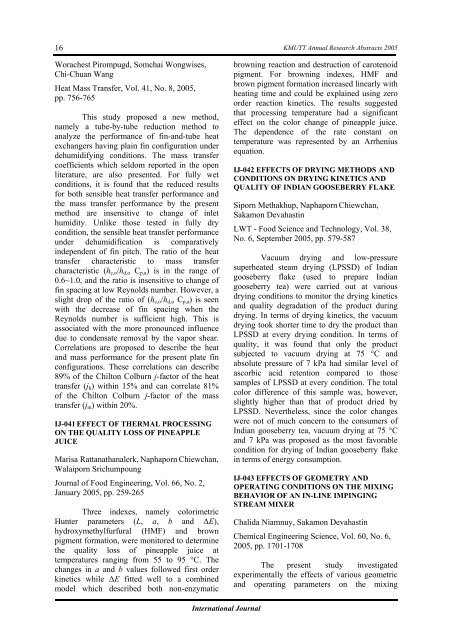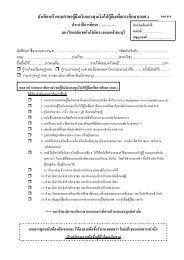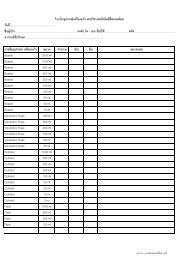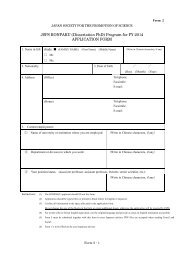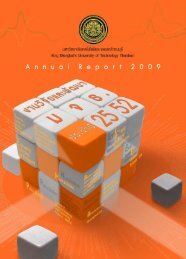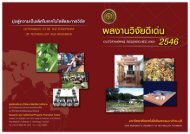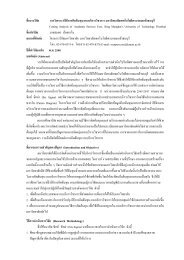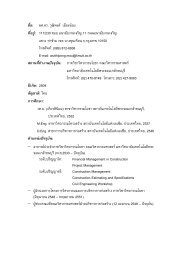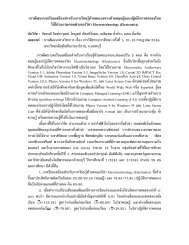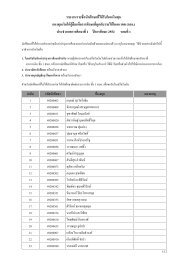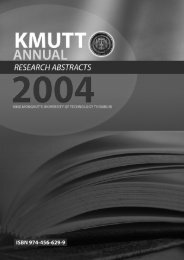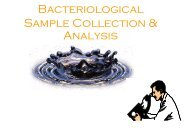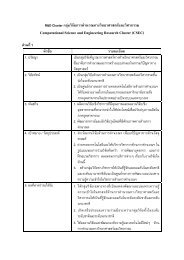Create successful ePaper yourself
Turn your PDF publications into a flip-book with our unique Google optimized e-Paper software.
16<br />
Worachest Pirompugd, Somchai Wongwises,<br />
Chi-Chuan Wang<br />
Heat Mass Transfer, Vol. 41, No. 8, 2005,<br />
pp. 756-765<br />
This study proposed a new method,<br />
namely a tube-by-tube reduction method to<br />
analyze the performance of fin-and-tube heat<br />
exchangers having plain fin configuration under<br />
dehumidifying conditions. The mass transfer<br />
coefficients which seldom reported in the open<br />
literature, are also presented. For fully wet<br />
conditions, it is found that the reduced results<br />
for both sensible heat transfer performance and<br />
the mass transfer performance by the present<br />
method are insensitive to change of inlet<br />
humidity. Unlike those tested in fully dry<br />
condition, the sensible heat transfer performance<br />
under dehumidification is comparatively<br />
independent of fin pitch. The ratio of the heat<br />
transfer characteristic to mass transfer<br />
characteristic (h c,o /h d,o C p,a ) is in the range of<br />
0.6~1.0, and the ratio is insensitive to change of<br />
fin spacing at low Reynolds number. However, a<br />
slight drop of the ratio of (h c,o /h d,o C p,a ) is seen<br />
with the decrease of fin spacing when the<br />
Reynolds number is sufficient high. This is<br />
associated with the more pronounced influence<br />
due to condensate removal by the vapor shear.<br />
Correlations are proposed to describe the heat<br />
and mass performance for the present plate fin<br />
configurations. These correlations can describe<br />
89% of the Chilton Colburn j-factor of the heat<br />
transfer (j h ) within 15% and can correlate 81%<br />
of the Chilton Colburn j-factor of the mass<br />
transfer (j m ) within 20%.<br />
IJ-041 EFFECT OF THERMAL PROCESSING<br />
ON THE QUALITY LOSS OF PINEAPPLE<br />
JUICE<br />
Marisa Rattanathanalerk, Naphaporn Chiewchan,<br />
Walaiporn Srichumpoung<br />
Journal of Food Engineering, Vol. 66, No. 2,<br />
January 2005, pp. 259-265<br />
Three indexes, namely colorimetric<br />
Hunter parameters (L, a, b and ∆E),<br />
hydroxymethylfurfural (HMF) and brown<br />
pigment formation, were monitored to determine<br />
the quality loss of pineapple juice at<br />
temperatures ranging from 55 to 95 °C. The<br />
changes in a and b values followed first order<br />
kinetics while ∆E fitted well to a combined<br />
model which described both non-enzymatic<br />
KMUTT Annual Research Abstracts 2005<br />
browning reaction and destruction of carotenoid<br />
pigment. For browning indexes, HMF and<br />
brown pigment formation increased linearly with<br />
heating time and could be explained using zero<br />
order reaction kinetics. The results suggested<br />
that processing temperature had a significant<br />
effect on the color change of pineapple juice.<br />
The dependence of the rate constant on<br />
temperature was represented by an Arrhenius<br />
equation.<br />
IJ-042 EFFECTS OF DRYING METHODS AND<br />
CONDITIONS ON DRYING KINETICS AND<br />
QUALITY OF INDIAN GOOSEBERRY FLAKE<br />
Siporn Methakhup, Naphaporn Chiewchan,<br />
Sakamon Devahastin<br />
LWT - Food Science and Technology, Vol. 38,<br />
No. 6, September 2005, pp. 579-587<br />
Vacuum drying and low-pressure<br />
superheated steam drying (LPSSD) of Indian<br />
gooseberry flake (used to prepare Indian<br />
gooseberry tea) were carried out at various<br />
drying conditions to monitor the drying kinetics<br />
and quality degradation of the product during<br />
drying. In terms of drying kinetics, the vacuum<br />
drying took shorter time to dry the product than<br />
LPSSD at every drying condition. In terms of<br />
quality, it was found that only the product<br />
subjected to vacuum drying at 75 °C and<br />
absolute pressure of 7 kPa had similar level of<br />
ascorbic acid retention compared to those<br />
samples of LPSSD at every condition. The total<br />
color difference of this sample was, however,<br />
slightly higher than that of product dried by<br />
LPSSD. Nevertheless, since the color changes<br />
were not of much concern to the consumers of<br />
Indian gooseberry tea, vacuum drying at 75 °C<br />
and 7 kPa was proposed as the most favorable<br />
condition for drying of Indian gooseberry flake<br />
in terms of energy consumption.<br />
IJ-043 EFFECTS OF GEOMETRY AND<br />
OPERATING CONDITIONS ON THE MIXING<br />
BEHAVIOR OF AN IN-LINE IMPINGING<br />
STREAM MIXER<br />
Chalida Niamnuy, Sakamon Devahastin<br />
Chemical Engineering Science, Vol. 60, No. 6,<br />
2005, pp. 1701-1708<br />
The present study investigated<br />
experimentally the effects of various geometric<br />
and operating parameters on the mixing<br />
International Journal


